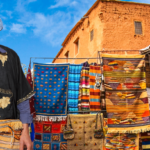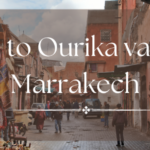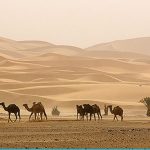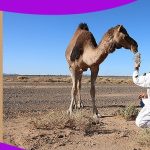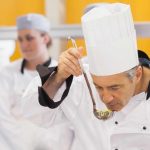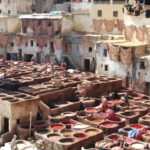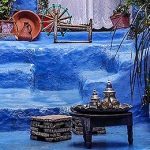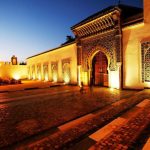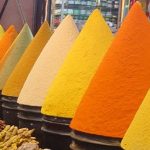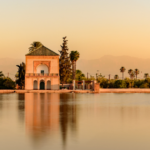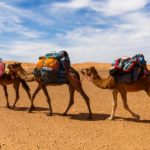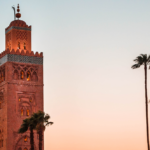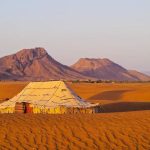Discover the captivating world of Moroccan rugs, where each type is a story woven with tradition and craftsmanship. From the vibrant Azilal rugs to the timeless beauty of Taznakht and Ourika designs, and not forgetting the rustic charm of desert rugs like Zagora, these cultural gems bring a touch of Morocco’s heritage into your home. Join us on a journey through tradition and style, as we explore the diversity of Moroccan rug types.
Moroccan rugs have drawn people fervor of interior designers and homeowners all over the globe for their beautiful designs that represent its culture. Every rug is an artifact, intertwined with history and customs. Now, let us explore the types of woven Moroccan rugs according to their region.
Table of Contents
- 1. Traditional Moroccan Rugs
- 2. Contemporary Moroccan Rugs
- 3. Materials Used in Moroccan Rugs
- 3.1 The design elements in Moroccan Rugs are explained below:
- 4. Production Process
- 5. Factors Influencing Quality
- 6. Popular Usage and Decor Tips
- 7. Investing in Moroccan Rugs
- 8. Maintenance and Care
- 9. Sustainability and Ethics
- 10. Cultural Significance
- 11. Where to Look for Rugs Handcrafted in Morocco
- 12. Are Moroccan rugs expensive?
- 12.1 Tips for Buying a Moroccan Rug
- 13. Conclusion
- 14. FAQs
Traditional Moroccan Rugs
Variations in the traditional Moroccan styles are representative of particular locations and their unique cultural heritage.
Berber Rugs: They appeared from Berber tribes of Northern Africa and bear bold geometric patterns, made of natural wood texture.
Beni Ourain Rugs: The talented Berber women of the Atlas Mountains hand-weave these rugs with great attention to the smallest details. It is renowned for its exquisite geometric designs and wool pile.
Kilim Rugs: These meticulously crafted flat-woven rugs feature exquisite patterns in rich colors that reflect the amazing artistry of Moroccan weavers.
Boucherouite Rugs: Fashioned from recycled cloth, Boucherouite carpets demonstrate selective designs and jovial constructions such that every piece is original.
Contemporary Moroccan Rugs
Though traditional designs are still in demand, up-to-date Moroccan rugs represent the present twist to ancient techniques.
Azilal Rugs: Azilal rugs are like the funky artists of the rug world, bursting with personality and flair! Their background makes them famous for their whimsical abstract designs. Each rug is like a splash of paint on a blank canvas, instantly brightening any room they grace with their presence.
Taznakht Rugs: They are hand-woven using old traditional techniques with great care and attention to detail. The rugs of Taznakht are known for their beauty and the rich cultural heritage of the Souss region. They are beloved works of art that tell stories of tradition and craftsmanship passed down through the centuries.
Ourika Rugs: Inspired by the picturesque Ourika Valley. These rugs feature regional natural colors that add a great touch to the home.
Materials Used in Moroccan Rugs
Natural materials, such as wool and cotton, are used in making Moroccan rugs also synthetic ones for low prices.
Wool: Often valued for its strength and softness, wool is the most widespread material in Moroccan rug production.
Cotton: Cotton is widely used as a material for weaving that works as a sturdy foundation on which complex patterns and designs are built.
Silk: Silk is reserved for luxury rugs and makes Moroccan carpets elegant with a gold shimmering lightness in texture.
Synthetics: Although not as conventional, synthetic fibers such as nylon and polyester offer cheaper options without losing quality.
The design elements in Moroccan Rugs are explained below:
Moroccan carpets are weaved with centuries of culture and tradition, making them into living time capsules. Each carpet relates a tale about Morocco’s rich cultural past, from tribal tales to geometric wonders. So when you put down a Moroccan rug, you’re not just decorating your space; you celebrate a culture that has stood the test of time.
Geometric Patterns: Geometric patterns are distinctive and key design features in Moroccan rugs, from intricate diamonds to bold stripes representing a state of harmony.
Tribal Motifs: The many Moroccan rug designs have tribal symbols that are from generation to generation with each symbol having its own meaning.
Symbolism: Symbols and colors used in Moroccan rugs have their cultural significance, which can be a blessing or protection depending on the type of symbol or color used, mainly because it has to do with prosperity.
Color Palette: Moroccan rugs provide a vibrant color palette that exudes vitality and vibrancy! It’s like a carnival for your floors—imagine bright yellows, brilliant blues, and striking reds! These vivid colors represent the dynamic spirit and rich heritage of Moroccan culture; they are not only coincidental. You’re entering a world of color and culture when you place your toes on a Moroccan rug.
Production Process
It takes patience in the process of making a Moroccan carpet and requires skill, accuracy, and craftsmanship.
Weaving Techniques: Moroccan rugs are traditionally handwoven, and can come with slightly different variations from one generation to the next; this results in slight imperfections.
Dyeing Methods: The colors evocative of our Moroccan rugs come from natural dyes created with the whole you find in plants, minerals, and insects Colors have long-lasting pigments that are friendly to the environment.
Artisans’ Role: Talented artisans also make a vital contribution to the manufacturing process of Moroccan carpets, sustaining traditional methods while enhancing their cultural heritage.
Factors Influencing Quality
Let’s talk about what makes a Moroccan rug top-notch. It is not just about looks; there are a few important things that determine its quality and value.
First up, knot density. Imagine each knot as a tiny piece of the puzzle. The more knots per square inch, the finer the craftsmanship. And that means a rug that’s not just pretty but also sturdy and long-lasting.
The quality of the material used plays a major role. Whether it’s wool, silk, or a blend, the type and grade of materials used can make or break a rug. Think of it like choosing between scratchy polyester and luxurious cashmere for your sweater – it’s a game-changer for comfort and durability.
Last but definitely not least, craftsmanship is everything. Skilled artisans put their heart and soul into every weave, ensuring every thread is in its place and every pattern is perfect. It’s like watching a master painter create a masterpiece stroke by stroke – pure magic.
Popular Usage and Decor Tips
Moroccan rugs are the chameleons of home design; they fit into any space and bring a magical touch with them. These rugs are suitable for creating a modern, clean look or a warm, vividly colored ambiance. It resembles having a secret weapon in your arsenal for decorating! Discover the charm that a rug can bring to your space:
Statement Pieces: To add luxury, texture, and elegance to your living room or bedroom, use a Moroccan rug as its primary focal point.
Styling Tips: For an artistic style, combine a Moroccan rug with contemporary furniture, or mix and match several rug types to create a multilayered, bohemian atmosphere.
Room Complementing: Choose a rug size and shape that complements the dimensions of your room, whether it’s a runner for a hallway or a large rug for a spacious living area.
Investing in Moroccan Rugs
Finding a Moroccan rug feels a bit like a trip on a treasure hunt. You want to be certain that you find one that is real. Below is the scoop on points to consider before spending money:
Proof of Authenticity: Choose rugs with incredible handcrafted symbols and designed using age-old methods by trusted artisans. These carpets are not mass-produced; instead, they’re woven with love and tradition, so you know you’re getting the real deal when it comes to originality and quality.
Price Range: Because Moroccan carpets are made in a variety of sizes and forms, there can be a wide range in the prices. Therefore, choose your budget before you go shopping. In this manner, when you finally locate the ideal rug, you won’t lose money or come away empty-handed.
Longevity: This is the finest part: a high-quality Moroccan rug is an investment that will last for generations, not just a passing fad. These lovely people will continue to shine with a little gentle loving care.
Maintenance and Care
Here are some modest care suggestions you can do to ensure your Moroccan rug remains to look its best for many years to come:
Regular Cleaning: Use a handheld vacuum to quickly remove any embedded dirt or debris from your rug regularly. Have an obstinate stain? Not to worry! Simply apply a small amount of water and mild detergent to it, then gently blot it away.
Storage Advice: Roll up your rug and store it away in a cool, dry location out of direct sunlight when it’s not busy spicing up your room. This keeps your carpeting looking as new as a daisy by preventing any fading or damage.
Repair and restoration: Trust the professionals if your rug needs some additional care, whether it’s a lost thread or a stubborn stain that just won’t go away. Rugs can be kept in excellent condition and remain lovely and comfortable for many years by hiring an experienced rug cleaner or restorer.
Sustainability and Ethics
Many Moroccan rug artisans believe it’s essential to care for the environment and the individuals who invest a lot of time in weaving these gorgeous rugs. This is how they go about it:
Fair Trade Practices: Look for rugs that have earned the Fair Trade certification while you’re shopping for one. This indicates that the craftspeople who created them are receiving proper treatment, including just compensation and favorable working circumstances.
Impact on the Environment: Want to do your part to protect the environment? Choose carpets manufactured from environmentally friendly materials and natural colors. This way, you can reduce any harm to the environment and contribute to making a greener planet.
Community Support: Purchasing a Moroccan rug directly from the cooperatives or craftsmen who manufacture it allows you to do more than simply acquire a gorgeous rug; you’re also supporting the local economy. By supporting locals, you help preserve their customs and keep their wallets full. Everyone wins in this situation!
Cultural Significance
Moroccan rugs hold deep cultural significance as symbols of heritage, identity, and craftsmanship.
Heritage Preservation: The woven carpets are linked to the cultural heritage of the rich region. They keep age-old weaving methods and traditions alive and ensure that Morocco’s heritage continues to flourish.
Symbol of Moroccan Identity: Moroccan carpets reflect many cultural identities through symbols and artistic personal inspirations, from Berber tribes to urban artists.
Empowerment of Craftspeople: The weaving of Moroccan rugs provides craftspeople with a stable means of living, enhancing communities, and preserving traditional skills for the next generation.
Where to Look for Rugs Handcrafted in Morocco
There are several procedures to make it happen, whether you want to purchase it online from the comfort of your couch or while you are in Morocco. This is a brief guide:
Local Souks: Take a tour of the busy shops and souks in major cities like Fez and Marrakech, where you can bargain with sellers and locate unusual rug treasures.
Internet merchants: There are a large of web shops specializing in Moroccan rugs and provide a broad range of designs, sizes, and pricing points to suit all budgets and tastes.
Specialized Boutiques: Visit expert rug boutiques and stores throughout the globe that curate collections of authentic Moroccan carpets and offer knowledgeable advice and assistance.
Are Moroccan rugs expensive?
Moroccan rug prices can fluctuate significantly based on factors like size, age, material quality, and weaving techniques. For instance, smaller rugs may range from 400 to 4,000 Moroccan dirhams, whereas larger, older, or intricately designed ones can fetch prices anywhere from 10,000 to 25,000 dirhams, or even higher.
Tips for Buying a Moroccan Rug
When diving into the world of Moroccan rugs, remember that bargaining is more than just a transaction—it’s part of the culture! Feel free to negotiate, with around 30% off their initial price often being a good starting point. You can find more information about how much Moroccan rugs cost in a recent blog post.
Seek out rugs that carry the mark of craftsmanship, handmade with care, rather than those churned out by machines. These pieces not only boast authenticity but also tend to hold up better over time.
When you want to choose a carpet, focus on timeless designs that speak to your soul and won’t go out of style. Make sure it fits your space perfectly by measuring carefully and aiming for the right balance that brings harmony to your space.
Also, take time to appreciate the colors and designs woven into each rug. Consider how you can combine these rugs with your interior design to add charm to your space.
Conclusion
Moroccan rugs are artworks that capture centuries of culture, and artistry; they are more than just floor coverings. There is a Moroccan rug for every taste and space, whether you are drawn to the classic charm of Berber carpets or the modern flair of Azilal designs. Investing in a Moroccan rug not only improves the aesthetics of your house but also helps artisan communities and sustainable practices, preserving a treasured cultural heritage for future generations.
FAQs
1. Are Moroccan carpets only suitable for traditional interior design?
Moroccan carpets go well with many types of interior design, including modern. They are the ideal accent for any area because of their adaptable designs and brilliant colors.
2. How can I determine the authenticity of a Moroccan rug?
Seek natural materials and handcrafted rugs made with ancient weaving methods. The attractiveness and genuineness of authentic Moroccan rugs are frequently enhanced by their flaws and quirks.
3. Is it possible to customize a Moroccan rug to suit my unique style preferences?
Moroccan carpet customization possibilities are widely available from designers and rug dealers, giving you the freedom to choose the colors, patterns, and sizes that best suit your interior. Although they could take longer to make, customized rugs provide your decor with a unique touch.
Join countless satisfied travelers who have experienced Morocco with us. We customize every detail to make your Moroccan adventure uniquely yours. Explore the Magic of Morocco with us!




























